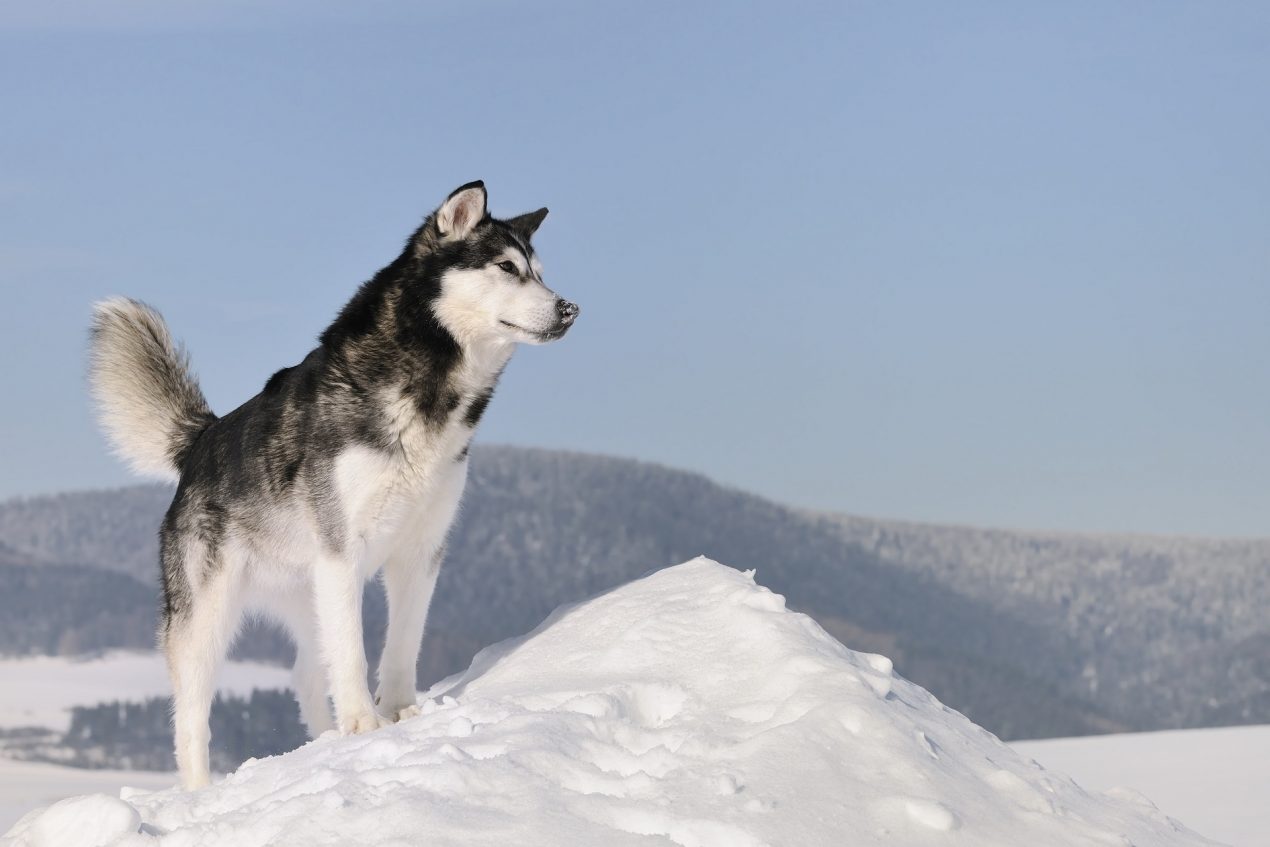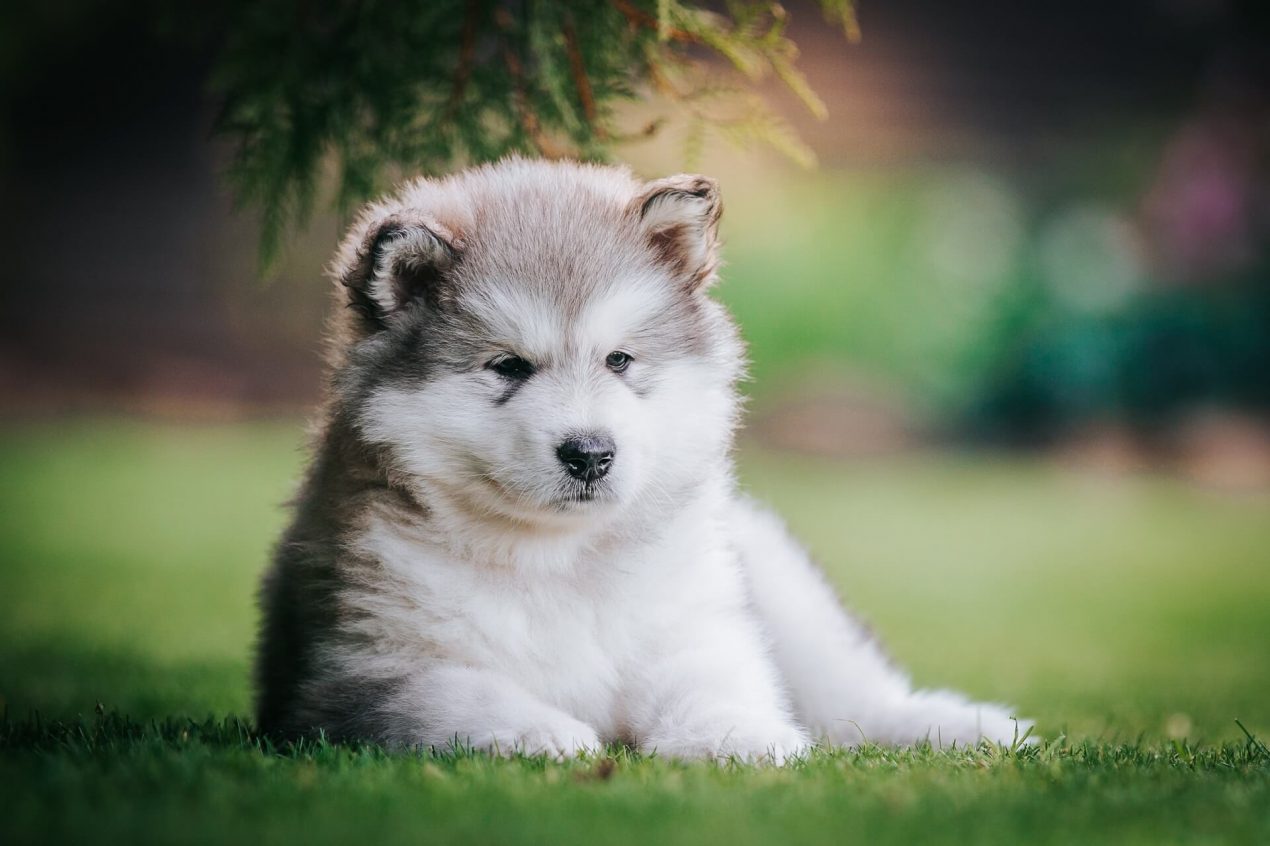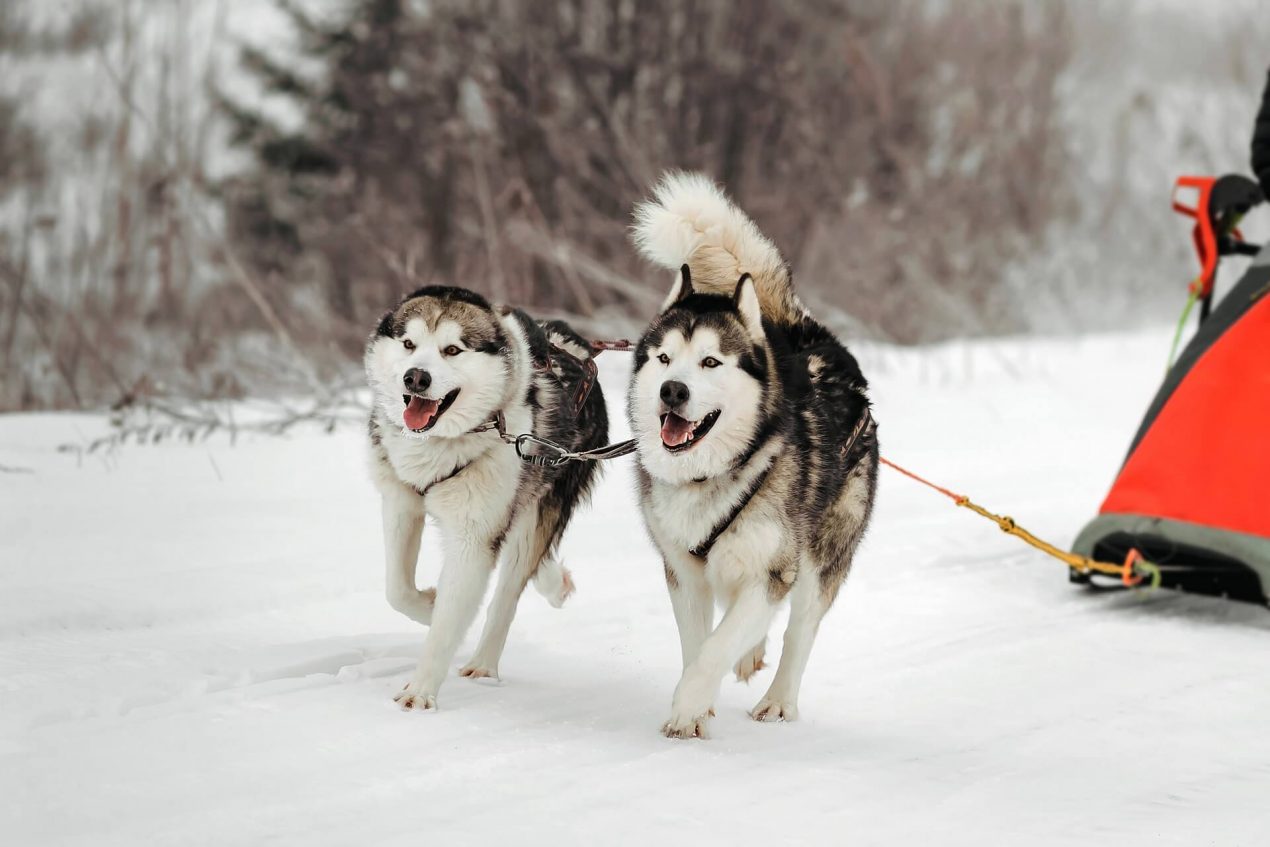The Alaskan Malamute is often referred to as the “locomotive of the North.” Here you’ll learn more about this Northern breed, accustomed for centuries to pulling heavy loads.
History of the Alaskan Malamute
The history of the Alaskan Malamute dates back to prehistoric times. The oldest finds are 9,000 years old and come from Siberia. In the constant frost, the remains of the dogs were well preserved. During the last ice age, the Bering Strait was covered in ice, allowing people to walk from Siberia to Alaska. Their dogs accompanied the hunters. They were loyal helpers in the hunt.
Throughout the centuries, they were indispensable companions to the people of the North. They pulled their sleds and kept them warm at night. Therefore, particularly strong dogs with the best hunting qualities were selected for breeding. Appearance was not a priority in this selection process. The four-legged companions were named after the Inuit tribe “Dog of the Mahlemiut)”.
In the 19th century, a sport in Alaska became increasingly popular: sled dog racing. The Malamutes became stars and gained public attention. To improve their performance, breeders crossed them with other breeds. This almost meant the end of the original Malamutes. Rescue came in the 1920s. Enthusiasts set out to visit Inuit tribes still living apart from civilization and found unadulterated Malamutes there.
They began breeding with some of them. The Alaskan Malamute Club of America was founded in 1935, and breed standards were formulated. In the same year, the Alaskan Malamutes were also recognized by the American Kennel Club. The FCI recognized the breed in 1963.
Breed Overview
GROUP: Working
HEIGHT: 24 to 27 inches (males); 22 to 24 inches (females)
WEIGHT: 85 pounds (males); 75 pounds (females)
COAT: Thick double coat
COAT COLOR: Solid white or combinations of white and gray, seal, red, black, or silver
LIFE SPAN: 10 to 12 years
TEMPERAMENT: Friendly, loyal, playful, affectionate, bright, courageous
HYPOALLERGENIC: No
ORIGIN: Alaska
Nature and Character
Alaskan Malamutes are working dogs. They are used to moving a lot and also need the exercise. As hunting companions, they like to think independently. They are not pure followers with unquestioning obedience; they want to understand why they should obey a command. Alaskan Malamutes are also used to living in packs. Although they are loyal to their human, they are generally not a dog for one person.
They are friendly to all people. Therefore, they would be completely unsuitable as guard dogs, as they would also welcome a burglar’s visit. They get along well with children. In their Arctic homeland, they often cuddled with children, and at night, child and dog often warmed each other. However, you should never leave such a strong dog alone with a child.

Whether they get along with other dogs depends on their sympathy. They are generally tolerant, but they don’t like to be bullied and will defend themselves if necessary. The hunting instinct of the Alaskan Malamute is strong, making cohabitation with other animals difficult. An adult Alaskan Malamute exudes a lot of dignity but remains playful and adventurous. An apartment in the city is not suitable for these dogs.
They love being outdoors. Therefore, a garden is almost mandatory if you are considering keeping an Alaskan Malamute. However, this should be well and deeply secured because Alaskan Malamutes are considered escape artists. You shouldn’t be too attached to your garden plants because they love to dig and rummage in the soil. They can also dig well under a fence.
| Affection Level | High |
| Friendliness | High |
| Kid-Friendly | High |
| Pet-Friendly | Medium |
| Exercise Needs | High |
| Playfulness | Medium |
| Energy Level | High |
| Trainability | Medium |
| Intelligence | High |
| Tendency to Bark | Low |
| Amount of Shedding | High |
Acquiring an Alaskan Malamute
You want an Alaskan Malamute? That’s understandable because Alaskan Malamutes look great, and under the right conditions, they are great family dogs. But before you start looking for a breeder, you should carefully consider whether the Alaskan Malamute breed is really suitable for you. Unfortunately, it happens all too often that Alaskan Malamutes are given up to shelters because their owners did not research enough beforehand. You wouldn’t want that to happen to your dog.
What should I consider when buying?
If you have decided on an Alaskan Malamute as a breed, then you should place great importance on finding a reputable breeder. Unfortunately, breeders take advantage of the popularity of this breed. Therefore, you should not respond to supposedly cheap offers in classified ads. Even if papers are presented to you, they are usually forged. A loving, responsible breeding comes at a price. You should expect to pay between $1,000 and $1,200 for a puppy. However, in return, you will receive a puppy that has been lovingly raised and cared for in the pack. Furthermore, it is healthy and has undergone all necessary examinations and vaccinations.
A responsible breeder will be there for you and your questions before and after the purchase, advising you on what to look out for. The easiest way to find a reputable breeder is through one of the two clubs affiliated with the AKC: the Alaskan Malamute Club and the American Club for Nordic Dogs.

Development and upbringing of the puppy
An Alaskan Malamute is not a dog for beginners. They are wilful and independent. Some even call them the cats among dogs. Therefore, you need iron consistency and a lot of patience for their upbringing. It should go without saying that you must not let yourself be swayed by sweet puppy eyes and give in to the motto “once is not enough.” However, iron consistency does not mean education with hardness, on the contrary. It’s hard to believe, but these large, strong dogs are quite sensitive.
For the education of the Alaskan Malamute, you need sovereignty and love. Then your dog will accept you as the pack leader and trust that your instructions are correct. He wants to be your companion, not just a simple follower. In general, you must expect the independent dog to “misbehave” throughout his life and do what he thinks is right. But if you have forged a close bond with him, he will do some commands for your sake, even if he doesn’t understand the sense behind them.
How do I keep an Alaskan Malamute?
Activities with the Alaskan Malamute:
An Alaskan Malamute will not be satisfied with just a daily walk, no matter how long it is. In addition, due to his strong hunting instinct, you should not let your dog run freely in nature without a leash. Even the best-trained Alaskan Malamute has his own mind, and he may forget all good education, which can have serious consequences. Many a wandering dog has had to pay for his deed with his life. If he breaks into an enclosure, you may face damage claims and will have to expect conditions.
If an Alaskan Malamute is not physically and mentally challenged, he will quickly become bored and start destroying the furnishings. Therefore, dog sports are essential. Ideally, he can do what his ancestors did for centuries: pulling loads. This is not only possible in ice and snow. There is also the possibility to train with a four-wheeled training cart or to let him pull a bicycle. Some Alaskan Malamutes also enjoy agility. However, you must generally consider that Malamutes are not sprinters but endurance athletes.

Health and Care
Alaskan Malamutes are easy to care for. It is sufficient to brush their coat with the dense undercoat once a week. During shedding, this may be necessary more often. During shedding, you should expect them to lose a lot of hair. The Nordic dog is accustomed to cooler temperatures and does not feel comfortable in extreme heat. Even at a temperature of 59°F (15 degrees Celsius), it can become too warm for them.
Therefore, you should move your activities with your dog to the early morning hours in summer and always have enough water with you. Inside the house, they should be able to rest in a cool place and always have water in their bowl. A strong, active dog naturally needs sufficient food. It should be of high quality and adapted to their activities. Alaskan Malamutes can also be fed a BARF diet very well.
Like all larger dogs, the Alaskan Malamute is prone to hip dysplasia. However, a reputable breeder will conduct appropriate examinations and advise you. Otherwise, Alaskan Malamutes are robust and can live well up to 12 years.
Interesting and Worth Knowing
Malamutes are often confused with Siberian Huskies. To distinguish them, a look into the eyes of the animal is sufficient. Alaskan Malamutes have brown eyes, while Huskies mostly have blue eyes.
The beautiful Alaskan Malamute is a popular dog in America. Many famous personalities, including actor Robin Williams and American President Hoover, lived with an Alaskan Malamute. Hollywood has also embraced the Nordic breed. Alaskan Malamutes played roles in films such as Call of the Wild, Dr. Quinn, and Indiana Jones.
Alaskan Malamute Overview
Pros
- Friendly and outgoing with people
- Enjoys outdoor activities like hiking and biking
- Intelligent and loyal nature
Cons
- Excessive shedding
- Can become dominant with other pets
- Needs significant exercise and mental stimulation
Do you have an Alaskan Malamute or are you thinking of getting one? Tell us in the comments what makes them special in your opinion!


